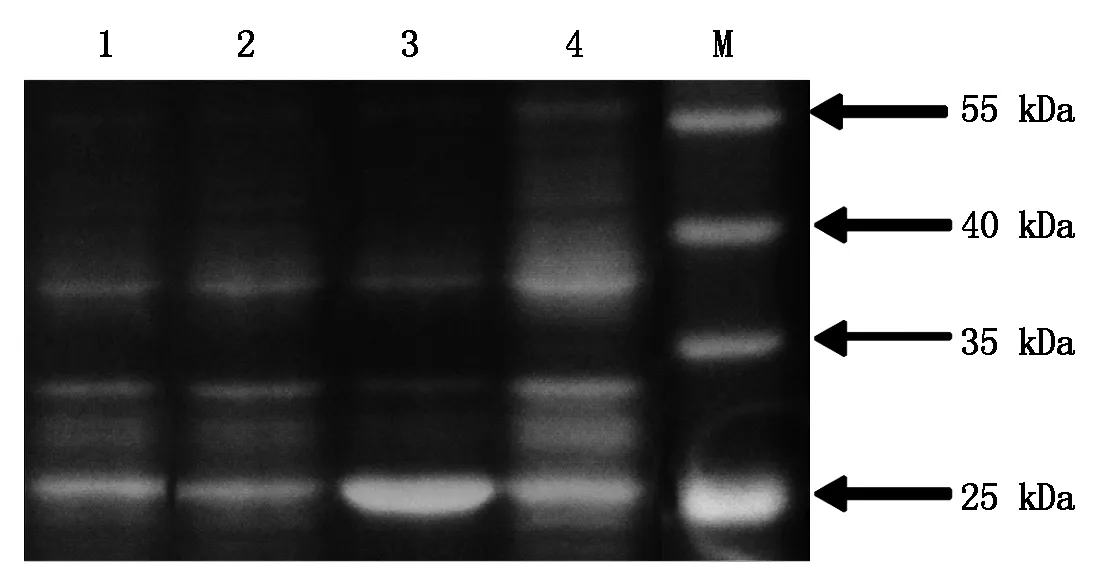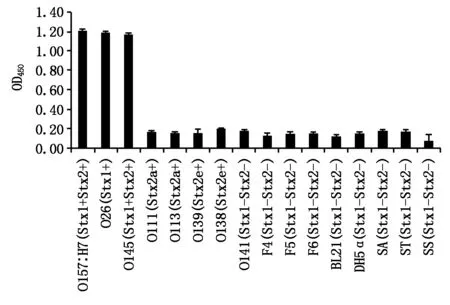肝片吸虫Fh8明显增强STEC的Stx1可溶性表达及Stx1单克隆抗体制备
张雪寒,张碧成,张 强,汪 伟,何孔旺
(江苏省农业科学院 兽医研究所,农业部兽用生物制品工程技术重点实验室,国家兽用生物制品工程技术研究中心,江苏 南京 210014)
肝片吸虫Fh8明显增强STEC的Stx1可溶性表达及Stx1单克隆抗体制备
张雪寒,张碧成,张 强,汪 伟,何孔旺
(江苏省农业科学院 兽医研究所,农业部兽用生物制品工程技术重点实验室,国家兽用生物制品工程技术研究中心,江苏 南京 210014)
志贺毒素1(Shiga toxin 1,Stx1),系五聚体蛋白,是产志贺毒素性大肠杆菌(Shiga Toxin-producingEscherichiacoli,STEC)主要的毒素因子,但Stx1体外极不易可溶性表达,旨在克隆和表达志贺毒素1(Shiga toxin 1,Stx1)A亚基,体外获得可溶性表达的Stx1,以研制单克隆抗体。生物信息学软件分析Stx1A亚基氨基酸序列,Stx1A1亚基N端为信号肽段,其C端高疏水性和低免疫原性。PCR扩增stx1A亚基73~759的687个核苷酸,与肝片吸虫Fh8基因串联,克隆到低温表达载体pCold Ⅰ 以构建重组菌,诱导表达重组毒素His-Fh8-Stx1A,SDS-PAGE分析蛋白表达形式。重组毒素His-Fh8-Stx1A免疫Balb/c小鼠,Sp2/0细胞融合筛选、制备阳性杂交瘤和单克隆抗体。PCR扩增Fh8和stx1a亚基并构建重组质粒pCold Ⅰ-His-Fh8-stx1,重组蛋白在原核细胞中得到高效表达,且以可溶性形式存在于菌体胞浆中。以重组His-Fh8-Stx1A为免疫原,成功制备3株能稳定传代并分泌Stx1的单克隆抗体(McAb)的杂交瘤细胞株,取其中1株成功制备高ELISA效价的腹水。Western Blot显示,纯化的单克隆抗体可与重组免疫原His-Stx1A和天然志贺毒素1发生特异性反应。本试验成功可溶性表达志贺毒素1A亚基,并获得多株单克隆抗体,为研制用于检测STEC的夹心ELISA和胶体金试纸条奠定理论基础。
产志贺毒素大肠杆菌;志贺毒素1;肝片吸虫;Fh8;可溶性表达;单克隆抗体
志贺毒素属于1个定义的蛋白亚家族,即RNA N-糖苷酶,又分为2种:Shiga toxin(Stx 1) 和Stx 2[1]。Stxs是典型的AB模式蛋白毒素,完整的毒素由1个A亚单位(32 kDa)和5个B亚单位(7.7 kDa单聚体)组成[2]。A亚单位具有毒素生化活性,由A1(28 kDa)和A2(4 kDa)2个部分通过二硫键连接,B亚单位是受体结合蛋白,介导与靶细胞膜受体特异性结合,致使毒素分子内化,其靶细胞主要为肠黏膜细胞、血管上皮细胞、肾和神经组织细胞等[3-5]。
1977年Konowalchuk等[6]首次在大肠杆菌中发现Stxs以来,经历了30余年的研究,致力于研究预防性疫苗和治疗性制剂保护人类免于毒素的危害,但目前仍然缺乏有效预防、治疗和检测手段。现有报道多以StxB为研究靶标[7-10],研制抗体和毒素疫苗,而A亚单位因具有毒素生化活性,体外极不易表达成功,表达量极低,成为研究领域里的瓶颈。
Fh8是肝片吸虫在感染早期分泌的蛋白,因其分子量为8 kDa,故命名为Fh8[11-13]。Fh8融合标签是高效的蛋白可溶性表达增强子,它的分子量小,相比现有的大融合标签具有先天优势。本试验拟将Fh8与Stx1A融合表达,以期获得可溶性蛋白,免疫小鼠,制备高滴度单克隆抗体,为研制志贺毒素检测技术和致病机制奠定基础理论数据。
1 材料和方法
1.1 菌株、质粒和试剂
大肠杆菌O157:H7(Stx1+ Stx2+)、O26(Stx1+)、O111(Stx2+)、O113(Stx2+)、O145(Stx1+ Stx2+)、O139(Stx2e+)、O138(Stx2e+)、O141(Stx1-Stx2-)、F4(Stx1-Stx2-)、F5(Stx1-Stx2-)、F6(Stx1-Stx2-)、BL21(Stx1-Stx2-)和DH5α(Stx1-Stx2-),以及不同种属的其他易混淆病原菌,金黄色葡萄球菌(Staphylococcusaureus,SA)、鼠伤寒沙门氏菌(Salmonellatyphimurium,ST)、链球菌(Streptococcussuis,SS),均由江苏省农业科学院兽医研究所保存;BL21(DE3)/pColdⅠ-stx1和BL21(DE3)/pET42a-stx1,均由江苏省农业科学院兽医研究所前期自行构建;质粒pUC57-Fh8、pColdⅠ(AmpR)、志贺毒素1(Stx1)粗提物,由江苏省农业科学院兽医研究所保存;PEG4000、HAT、HT、DMSO,购自Sigma 公司;DMEM、小牛血清,Gibco公司;HRP羊抗鼠-IgG,购自博士德生物技术公司;明胶,购自Sunshine公司;His-Bind Purification Kit,购自Novagen公司;Protein A IgG Purification Kit购自美国Pierce公司;预染蛋白标准品(BlueRay Prestained Protein Ladder),购自GeneDirex公司。
1.2 细胞和动物
骨髓瘤细胞Sp2/0,由江苏省农业科学院兽医研究所保存;Balb/c小鼠,由扬州大学医学中心提供。
1.3 引物设计
根据肝片吸虫Fh8基因序列(GenBank 登录号:AF213970)和STEC O157∶H7志贺毒素1基因序列(GenBank 登录号:AY633473.1),分别设计引物,扩增Fh8全长和stx1亚基73~759核苷酸片段,下划线显示酶切位点,引物序列如下:
Fh8-F:5-AGGCATATGATGCCTAGTGTTCAAGA G-3NdeⅠ,
Fh8-R:5-TGTGTCGACTGATGACAAAATCGAA AC-3XhoⅠ;
stx1-AF:5-CGCGAATTCTTTACCTTAGACTTC-3XhoⅠ,
stx1-AR:5-GTTGTCGACTGCATTAATGCTTCC-3SalⅠ。
1.4 重组菌构建和蛋白表达
1.4.1 重组菌的构建 以pUC57-Fh8质粒为模板,PCR扩增Fh8全长基因,克隆入低温表达质粒 pColdⅠ;常规煮沸方法制备STEC O157∶H7模板,PCR扩增stx1截短基因片段,克隆到Fh8基因之后,构建Fh8-stx1融合基因,转化宿主菌BL21(DE3),构建重组菌BL21(DE3)/pColdⅠ-Fh8-stx1。
1.4.2 重组蛋白的表达 阳性重组菌BL21(DE3)/pColdⅠ-Fh8-stx1过夜培养物,按照2%比例接种LB液体培养基,37 ℃振摇培养2 h(OD600=0.4),加入IPTG,终浓度为0.1 mmol/L,16 ℃继续培养9 h。BL21(DE3)/pET42a-stx1和BL21(DE3)/pColdⅠ-stx1菌种,37 ℃过夜培养,按照2%比例接种LB液体培养基,37℃振摇培养2 h(OD600=0.4),加入IPTG,终浓度为0.1 mmol/L,30 ℃继续培养5 h。离心收集细菌培养物,PBS缓冲液重悬菌泥,超声波破碎裂解(功率55%,20 min),12 000 r/min离心10 min,分别收集菌体上清和沉淀,SDS-PAGE分析重组蛋白表达情况。
1.5 单克隆抗体制备和鉴定
1.5.1 蛋白纯化 按照1.4.2中方法诱导重组蛋白,参照 His·BindTMResin 亲和层析柱操作说明,纯化超声波菌体上清,获得高纯度可溶性重组蛋白,分子量33 kDa。
1.5.2 小鼠免疫 选用5只6周龄的雄性Balb/c小鼠进行免疫,首次腹腔注射等量弗氏完全佐剂乳化的抗原50 μg/只,14 d后腹腔注射弗氏不完全佐剂乳化的等量抗原,再间隔14 d,以等量抗原腹腔注射,当小鼠血清效价达到1∶10 000以上时,常规方法进行细胞融合,间接ELISA方法筛选杂交瘤细胞和亚克隆,阳性抗体杂交瘤细胞扩大培养,腹腔注射Balb/c小鼠,10 d后,腹围极度膨胀时,取腹水,检测其ELISA反应效价,-20 ℃ 保存。
1.5.3 腹水效价测定和纯化 将重组蛋白His-Fh8-Stx1调整为2 μg/mL 的抗原溶液加入到96 孔ELISA板中,100 μL/孔,4 ℃孵育过夜。将腹水1∶1 000、1∶2 000、1∶4 000、1∶8 000,1∶16 000、1∶32 000、1∶64 000,1∶128 000、1∶256 000、1∶512 000、1∶1 024 000和1∶2 048 000倍比稀释,100 μL/孔。HRP-羊抗小鼠IgG 1∶20 000稀释,间接ELISA检测,测定OD450吸光值。当比值(阳性孔/阴性孔)≥2.1时的最大稀释倍数的倒数即为抗体滴度(表1)。收集小鼠腹水,参照Protein A IgG Purification Kit(Pierce公司,美国)进行抗体纯化。
1.5.4 单克隆抗体特异性 检测受试菌株包括不同血清型大肠杆菌以及不同种属的其他易混淆病原菌。上述菌株培养后,12 000 r/min离心5 min,0.01 mol/L PBS重悬,调整菌液浓度为1×106cfu/mL,超声破碎(功率50%,2 min),12 000 r/min离心10 min,上清用于包被ELISA板,包被浓度为1 μg/mL,小鼠腹水1∶2 000稀释,间接ELISA测定OD450吸光值。
1.6 Western Blot检测
志贺毒素1(Stx1)粗提物和重组蛋白Fh8-Stx1A进行SDS-PAGE分析,单克隆抗体1∶1 000倍稀释作为一抗,HRP-羊抗小鼠IgG为二抗,ECL显色分析。
2 结果与分析
2.1 重组菌构建和蛋白表达
依次将肝片吸虫Fh8全基因和截短的stx1基因A亚基75~759之间687个核苷酸克隆入低温表达质粒 pColdⅠ,构建重组质粒,NdeⅠ和SalⅠ双酶切,可见896 bp的融合基因片段(图1)。

M.DNA 标准;1~3.阳性重组质粒pColdⅠ-Fh8-stx1。
双酶切鉴定正确的重组质粒pColdⅠ-Fh8-stx1,转化宿主菌BL21(DE3),获得重组菌BL21(DE3)/pColdⅠ-Fh8-stx1,IPTG诱导9 h,SDS-PAGE显示重组蛋白以可溶性形式存在于菌体胞浆,分子量33 kDa(图2)。BL21(DE3)/pET42a-stx1(图3)和BL21(DE3)/pColdⅠ-stx1(图4)表达重组蛋白以包涵体形式存在于菌体沉淀中,为非可溶性蛋白,分子量分别为53,25 kDa。

M.蛋白质标准;1.重组菌BL21/pCold Ⅰ-Fh8-stx1 诱导后的全菌裂解物;2.重组菌BL21/pCold Ⅰ-Fh8-stx1诱导后全菌裂解物的上清;3.重组菌 BL21/pCold Ⅰ-Fh8-stx1诱导后全菌裂解物的沉淀;4.重组菌BL21/pCold Ⅰ-Fh8-stx1诱导前全菌裂解物。
M.Protein Ladder;1.Whole-cell lysate of BL21/pCold Ⅰ-Fh8-stx1 after induction by IPTG;2.Supernatants from whole-cell lysate of BL21/pCold Ⅰ-Fh8-stx1 after induction by IPTG;3.Pellets from whole-cell lysate of BL21/pCold Ⅰ-Fh8-stx1 induction by IPTG;4.Whole-cell lysate of BL21/pCold Ⅰ-Fh8-stx1 before induction by IPTG.
图2 SDS-PAGE分析重组菌BL21/pColdⅠ-Fh8-stx1蛋白表达
Fig.2 SDS-PAGE analysis of recombinant protein expression in BL21/pCold Ⅰ-Fh8-stx1
2.2 单克隆抗体检测
2.2.1 抗体滴度 经融合获得3株单克隆抗体,分别为4D8、2B7和4B9,选取2B7接种小鼠制备腹水,当腹水1∶512 000稀释时,P/N=3.67,抗体滴度为5.12×105(表1)。

M.蛋白质标准;1~2.重组菌 pET42a-stx1诱导前全菌裂解物;3.重组菌pET42a-stx1 诱导后全菌裂解物的沉淀;4.重组菌 pET42a-stx1 诱导后全菌裂解物的上清;5.重组菌 pET42a-stx1诱导后全菌裂解物。
M.Protein Ladder;1-2.Whole-cell lysate of pET42a-stx1 before induction by IPTG;3.Pellets from whole-cell lysate of pET42a-stx1 after induction by IPTG;4.Supernatants from whole-cell lysate of pET42a-stx1 after induction by IPTG;5.Whole-cell lysate of pET42a-stx1 after induction by IPTG.
图3 SDS-PAGE分析重组菌BL21/pET42a-stx1蛋白表达
Fig.3 SDS-PAGE analysis of recombinant protein expression in BL21/pET42a-stx1

M.蛋白质标准;1~2.重组菌 BL21/pCold Ⅰ-stx1诱导前全菌裂解物;3.重组菌BL21/pCold Ⅰ-stx1诱导后全菌裂解物的沉淀;4.重组菌 BL21/pCold Ⅰ-stx1诱导后全菌裂解物的上清。
M.Protein Ladder;1-2.Whole-cell lysate of BL21/pCold Ⅰ-stx1 before induction by IPTG;3.Pellets from whole-cell lysate of BL21/pCold Ⅰ-stx1 after induction by IPTG;4.Supernatants from whole-cell lysate of BL21/pCold Ⅰ-stx1 after induction by IPTG.

图4 SDS-PAGE分析重组菌BL21/pCold Ⅰ-stx1蛋白表达
2.2.2 抗体纯化 小鼠腹水经纯化后,SDS-PAGE显示55,25 kDa的重链和轻链(图5)。

M.蛋白质标准;1.纯化的小鼠腹水。

图6 单抗特异性分析
2.2.3 抗体特异性 大肠杆菌O157∶H7(Stx1+ Stx2+)、O26(Stx1+)、O145(Stx1+ Stx2+)OD450均明显高于其他菌株(图6)。
2.2.4 Western Blot 检测 单克隆抗体与志贺毒素1(Stx1)粗提物和重组Fh8-Stx1a反应良好,均出现预期条带,分别为25,33 kDa(图7)。
3 讨论
产志贺毒素性大肠杆菌(Shiga toxin-producingEscherichiacoli,STEC) 是重要的食源性病原菌之一,能够导致人类严重的疾病,诸如出血性肠炎(Hemorrhagic enteritis,HC)和溶血尿毒综合征(Hemolyticuremic syndrome,HUS)等,个别患者可因急性和慢性肾功能衰竭而死亡[5]。动物感染一般不引发明显的临床症状,但能够长期甚至终生携带[14-15]。污染的肉品、奶制品以及蔬菜等食物是传播STEC主要的媒介[16]。

M.蛋白质标准;1~2.纯化蛋白Fh8-Stx1;
志贺毒素是STEC主要的致病因子,是由整合到细菌基因组中的溶源性噬菌体编码,包含2个免疫学上没有交叉反应的型,分别为Stx1和Stx2[17]。尽管Stx1和Stx2蛋白晶体结构具有较高的相似性,但A亚基和B亚基氨基酸水平的同源性仅为32%和27%[18],表明二者的生物学特性可能存在较大差异,对于它们检测和防控也应区别对待。根据毒素与宿主的亲和力、细胞的毒性、动物的致病性以及对肠黏液激活的反应性等,Stx1和Stx2又被人为地划分为多个亚型,Stx1有Stx1a、Stx1c和Stx1d 3个亚型[19-20],而Stx2有Stx2a、Stx2b、Stx2c、Stx2d、Stx2e、Stx2f和Stx2g 7个亚型[21-22]。
目前,研制Stx1的单克隆抗体大多以Stx1B亚基为免疫原而获得[7-10,23],表现出良好的有效性,但随着更多亚型的涌现,变异位点发生在A亚基,现有单克隆抗体不能加以区分。因此,本试验选取A亚基毒素活性中心为免疫原,研制针对性的单克隆抗体,将特异的检测各种优势的毒素亚型。
良好的免疫原是高质量单克隆抗体的保障。在前期研究中,尝试克隆全长stx1A基因到多个表达载体中,如pET42a、pET32a和低温表达载体pCold I中,只有痕量包涵体表达。本试验通过对stx1A氨基酸序列的分析,只扩增A亚基的毒素活性中心基因片段,尝试克隆入多个表达载体,蛋白表达量有明显提高,但仍为非可溶性蛋白。Fh8肽段是肝片吸虫感染早期分泌的蛋白,具有成为可溶性表达增强子的先天优势[11-13]。本试验构建Fh8-stx1A融合基因,克隆入低温表达质粒中,成功过表达,并且为可溶性蛋白,解决了Stx1的体外表达难题。可溶性重组蛋白Fh8-Stx1A免疫小鼠,经过1次融合,获得3株高滴度单克隆株,其中2B7与Stx2无交叉反应,是Stx1特异性的单克隆抗体,为研制新的免疫检测试剂奠定物质基础。
综上所述,本试验成功克隆和表达Stx1的A亚基毒素活性中心,借助Fh8融合标签,获得可溶性蛋白,免疫小鼠,获得高滴度且高特异性的单克隆抗体。
[1] Calderwood S B,Auclair F,Donohue-Rolfe A,et al.Nucleotide sequence of the Shiga-like toxin genes ofEscherichiacoli[J].Proceedings of the National Academy of Sciences,1987,84:4364-4368.
[2] Shimizu H R A,Field S W,Homans S W,et al.Solution structure of the complex between the B-subunit homopentamer of verotoxin VT-1 fromEscherichiacoliand the trisaccharide moiety of globotriaosylceramide [J].Biochemistry,1998,37(31):11078-11082.
[3] Braune S A,Wichmann D,Von Heinz M C,et al.Clinical features of critically ill patients with Shiga toxin-induced hemolytic uremic syndrome[J].Critical Care Medicine,2013,41(7):1702-1710.
[4] Hunt J M.Shiga toxin-producingEscherichiacoli(STEC) [J].Clinics in Laboratory Medicine,2010,30(1):21-45.
[5] Ko H,Maymani H,Rojas-Hernandez C.Hemolytic uremic syndrome associated withEscherichiacoliO157:H7 infection in older adults:a case report and review of the literature[J].Journal of Medical Case Reports,2016,10(175):175.
[6] Konowalchuk J,Speirs J I,Stavric S.Vero response to a cytotoxin ofEscherichiacoli.infection and immunity[J].1977,18(3):775-779.
[7] Nakao H,Kataoka C,Kiyokawa N,et al.Monoclonal antibody to shiga toxin 1,which blocks receptor binding and neutralizes cytotoxicity[J].Microbiology and Immunology,2002,46(11):777-780.
[8] Smith M J,Carvalho H M,Melton-Celsa A R,et al.The 13C4 monoclonal antibody that neutralizes Shiga toxin Type 1(Stx1) recognizes three regions on the Stx1 B subunit and prevents Stx1 from binding to its eukaryotic receptor globotriaosylceramide[J].Infection and Immunity,2006,74(12):6992-6998.
[10] Mejias M P,Ghersi G,Craig P O,et al.Immunization with a chimera consisting of the B subunit of Shiga toxin type 2 and brucella lumazine synthase confers total protection against Shiga toxins in mice[J].Journal of Immunology,2013,191(5):2403-2411.
[11] Costa S J,Coelho E,Franco L,et al.The Fh8 tag:a fusion partner for simple and cost-effective protein purification inEscherichiacoli[J].Protein Expression and Purification,2013,92(2):163-170.
[12] Costa S J,Almeida A,Castro A,et al.The novel Fh8 and H fusion partners for soluble protein expression inEscherichiacoli:a comparison with the traditional gene fusion technology[J].Applied Microbiology and Biotechnology,2013,97(15):6779-6791.
[13] Costa S,Almeida A,Castro A,et al.Fusion tags for protein solubility,purification and immunogenicity inEscherichiacoli:the novel Fh8 system[J].Frontiers in Microbiology,2014,5(63):63.
[14] Venegas-Vargas C,Henderson S,Khare A,et al.Factors associated with Shiga toxin-producingEscherichiacolishedding in dairy and beef cattle[J].Applied and Environmental Microbiology,2016,82(20):816-829.
[15] Besser T E,Schmidt C E,Shah D H,et al."Preharvest" food safety forEscherichiacoliO157 and other pathogenic shiga Toxin-Producing strains[J].Microbiology Spectrum,2014,2(5):1-12.
[16] Seys S A,Sampedro F,Hedberg C W.Assessment of shiga Toxin-ProducingEscherichiacoliO157 illnesses prevented by recalls of beef products[J].Foodborne Pathogens and Disease,2015,12(9):800-805.
[17] Fraser M E,Chernaia M M,Kozlov Y V,et al.Crystal structure of the holotoxin from Shigella dysenteriae at 2.5 A resolution[J].Nature Structural Biology,1994,1(1):59-64.
[18] Fraser M E,Fujinaga M,Cherney M M,et al.Structure of shiga toxin type 2(Stx2) fromEscherichiacoliO157:H7[J].The Journal of Biological Chemistry,2004,279(26):27511-27517.
[19] Koch C,Hertwig S,Lurz R,et al.Isolation of a lysogenic bacteriophage carrying the stx(1(OX3)) gene,which is closely associated with Shiga toxin-producingEscherichiacolistrains from sheep and humans[J].Journal of Clinical Microbiology,2001,39(11):3992-3998.
[20] Paton A W,Beutin L,Paton J C.Heterogeneity of the amino-acid sequences ofEscherichiacoliShiga-like toxin type-I operons[J].Gene,1995,153(1):71-74.
[21] Scheutz F,Beutin L,Piérard D,et al.Nomenclature of verotoxins:a review,a proposal,and a protocol for typing vtx gene[C].In the 4th Annual Workshop of the National Reference Laboratories forE.coliin the EU,Rome,Italy,30 October 2009.
[22] Orth D,Grif K,Khan A B,et al.The shiga toxin genotype rather than the amount of shiga toxin or the cytotoxicity of shiga toxininvitrocorrelates with the appearance of the hemolytic uremic syndrome[J].Diagnostic Microbiology and Infectious Disease,2007,59(3):235-242.
[23] Li G,Hong J,Huo G,et al.Monoclonal antibodies against Stx1B subunit ofEscherichiacoliO157:H7 distinguish the bacterium from other bacteria[J].Letters in Applied Microbiology,2010,51(5):499-503.
Fasciolahepatica8 Significantly Enhances Soluble Expression of Stx1 from STEC and Stx1 Monoclonal Antibody Preparation
ZHANG Xuehan,ZHANG Bicheng,ZHANG Qiang,WANG Wei,HE Kongwang
(Institute of Veterinary Medicine,Jiangsu Academy of Agricultural Sciences,Key Laboratory of Engineering Research of Veterinary Bio-products of Agricultural Ministry,National Research Center of Veterinary Biologicals Engineering and Technology,Nanjing 210014,China)
Shiga toxin 1(Stx1),AB5 pentamers protein,is one of major virulent factors of Shiga Toxin-producingEscherichiacoli(STEC).The N-terminal fragment of Stx1A subunit encodes a signal peptide,and its C-terminal amino acid sequences presents high hydrophobicity and low immunogenicity by bioinformatics software analysis,and these features lead to expression failure and inclusion of target protein.In this study,our aim is to clonestx1 gene and express soluble protein for development of monoclonal antibodies against Stx1A.The 210 bp ofFh8 gene fromFasciolahepaticawas cloned into pCold Ⅰ withNdeⅠ andXhoⅠ,and the middle fragment between 73-759 ntofstx1Asubunit was amplified,fused withFh8 gene to construct recombinant strain of BL21(DE3)/pCold Ⅰ-Fh8-stx1.His-Fh8-stx1Awas immunized Balb/c mice to prepare positive hybridomas and monoclonal antibodies bySp2/0 cell fusion screening.We successfully constructed a recombinant plasmid pCold Ⅰ-Fh8-stx1a,expressed His-Fh8-Stx1A in prokaryotic cells in soluble form.Three stably secreting anti-Stx1A monoclonal antibodies(McAb) of hybridoma cell lines were developed,one of them was used to prepare high titer ascites.Western Blot assay showed ascites after purified are able to react with recombinant His-Fh8-Stx1A and Shiga toxin 1 crude extract.We successfully prepared soluble Stx1A protein with good antigenicity,and three monoclonal antibodies with high titers,these will lay substantial foundation for future study,i.e.developing sandwich ELISA and colloidal gold test strip to detect STEC.
Shiga toxin-producingEscherichiacoli;Shiga toxin 1;Fasciolahepatica;Fh8;Soluble expression;Monoclonal antibody
2016-07-26
国家自然科学基金项目(31572503);江苏省自主创新资金项目(CX(15)1060)
张雪寒(1977-),女,河北高碑店人,副研究员,博士,硕士生导师,主要从事食源性病原微生物风险评估和防控技术研究。
Q78
A
1000-7091(2016)05-0044-06
10.7668/hbnxb.2016.05.007

